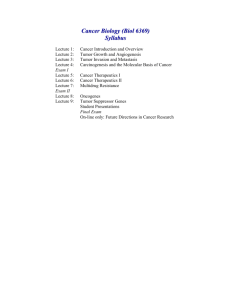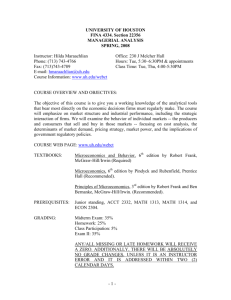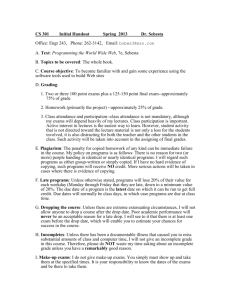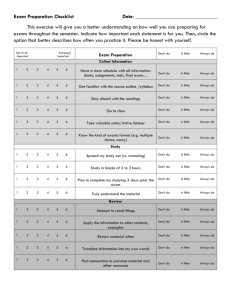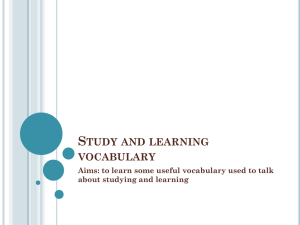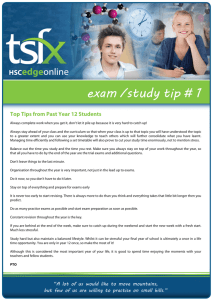- ShackmanLab
advertisement
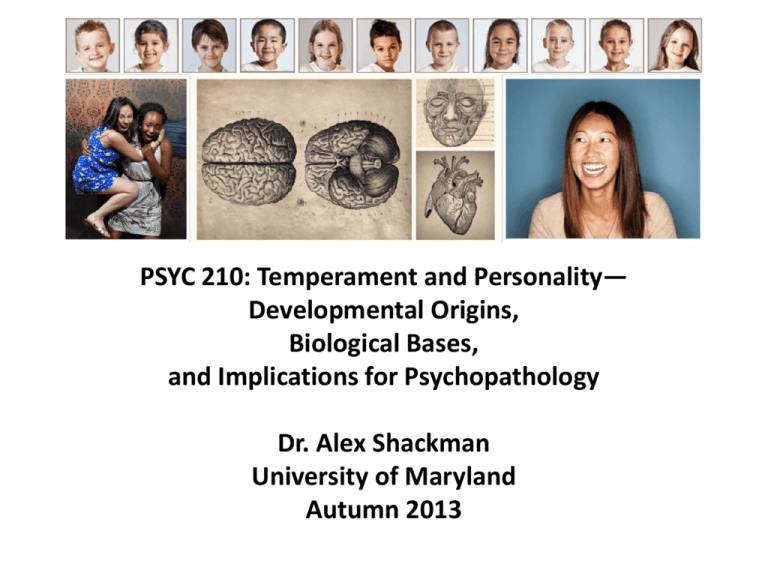
PSYC 210: Temperament and Personality— Developmental Origins, Biological Bases, and Implications for Psychopathology Dr. Alex Shackman University of Maryland Autumn 2013 Plan for Today 1. Round table discussion of T&P—fundamental questions (go to document) 2. Course mechanics and grading 3. Expert perspectives on T&P with short discussion between each video Welcome! Course Overview Goal Introduce you to a diverse array of theoretical and empirical issues related to the study of stable individual differences in temperament and personality (T&P). Course Objectives, 1 of 4 • A major goal of this course is to give you a broad, interdisciplinary background in T&P so that you can: – Be a critical consumer of this literature – Broaden the way you think about connections between the mind, brain, and behavior Course Objectives, 2 of 4 • Become experts on how T&P influence our daily lives and the mechanisms that link T&P to positive and negative outcomes Course Objectives, 3 of 4 • Develop a working knowledge of the neurobiology of T&P Course Objectives, 4 of 4 • Know and understand the fundamental questions A multi-disciplinary perspective on the cutting-edge science of T&P A multi-disciplinary perspective on the cutting-edge science of T&P When a scientist doesn’t know the answer to a problem, he is ignorant. When he has a hunch as to what the result is, he is uncertain. And when he is pretty damn sure of what the result is going to be, he is still in some doubt…Scientific knowledge is a body of statements of varying degrees of certainty—some most unsure, some nearly sure, but none absolutely certain. —Richard Feynman (1955), Nobel Laureate A multi-disciplinary perspective on the cutting-edge science of T&P Science is not a body of facts established by experts, but a set of methods for estimating and reducing uncertainty; It is a process, at times messy or tedious, of grappling with nature and our preconceived notions about how it works. There are many, many fundamental questions about T&P that remain unresolved. That’s one of the things that make this class so fun! We haven’t figured it out and there are many challenges that remain for future research. A multi-disciplinary perspective on the cutting-edge science of T&P In this class you will learn about - the current state of our scientific knowledge about T&P - how T&P is organized in the brain - the implications for understanding psychopathology and other important outcomes. - some of the key techniques used for measuring and understanding T&P, including brain imaging techniques But we will not review the scientific history of personality research (e.g., Freud). A multi-disciplinary perspective on the cutting-edge science of T&P In general, I will emphasize a multi-disciplinary perspective Here, research at different levels of analysis, using different tools, samples, or species, is viewed as complementary and mutually informative. Put another way, the class will not be organized around “biological theories,” “psychoanalytic theories,” and so on. Course Structure Lectures Readings Lectures You are strongly encouraged to attend lecture Lectures will last ~90 minutes and will include the following components: • Brief cumulative review of material covered in prior lectures. – Many of the questions that will be featured on the exams will be covered during this period. – We’ll use Clickers, available at the bookstore • Roadmap outlining the topics to be covered • Lecture on the science of T&P – There will be plenty of time for questions and discussion • Recap of the most important take-home points • Critical take-home questions Lectures • On occasion, we will have special invited guest lectures • It is critical that you regularly attend class in order to do well in this course. • Although slides may be posted online, critical take-home questions will not be posted online. • I strongly encourage you take notes during class to ensure comprehension of the material. • It is important to emphasize that there are many opportunities for us to learn from one another in the classroom. Learning can stem from sharing knowledge or from asking questions. Assigned Readings Assigned Readings • Readings for this course have been hand-picked by the instructor; many are original empirical papers or reviews by leading scientists in the field. • What better way is there to learn about T&P then straight from the most exciting researchers working in the field today? • To get the most out of this course, it is important that you understand the readings. Please read the assigned papers before class that week. • Please do not hesitate to ask questions about anything you found confusing or challenging! • Readings will be available for download via the course website on Canvas. Grading 3 Exams 20 critical thinking questions Extra credit 3 Cumulative Exams • 30% each x 3 exams = 90% total grade • 2 midterm exams and a final exam • Exams will consist of multiple-choice and short-answer questions that involve critical thinking about concepts drawn from the readings and lectures. • The purpose of the exams is two-fold. – Demonstrate that you have read the material and understand the factual points and arguments. – Be able to synthesize and integrate the material such that this knowledge can be applied in a broader context. • Exams will take place in class • Open book and note • Review sessions before each exam in class • It is important to emphasize that much of what is covered in the exams is not contained in the lecture slides, so attendance and attention during class is critical to your success on the exams. 20 critical thinking questions • 20 questions (‘assignments’ ) x 0.5% each = 10% total grade • At the end of each lecture, beginning during the second week of class (i.e., the 3rd meeting), you will receive two critical thinking take-home questions • Responses will be assigned one of the following grades: 1 (full credit), 1⁄2 (half-credit), 0 (no credit). Grades will be made available in Canvas. • Unexcused late responses will be assigned a score of 0. • At the end of the semester, your two lowest response grades will be dropped. 20 critical thinking questions Each assignment will consist of your response to 2 questions: • 1 focused on the material described during the lecture and 1 focused on an aspect of the assigned reading that was not highlighted in the accompanying lecture. • Your response should be ~1 paragraph per question (i.e., total of 2 separate paragraphs). • Responses are due no later than 9:00am EST before the subsequent lecture (i.e., questions provided in class Tuesday are due by 9:00am Thursday that week; questions provided in class Thursday are due by 9:00am Tuesday the following week). • Additional details available in the syllabus on the course website (Canvas) Extra Credit 4 points of extra credit (out of 100 total points) Complete the Department Mass Survey using the SONA system See the syllabus for details Switching Gears: Expert perspectives on T&P David Watson: Personality Jerome Kagan: Temperament Stop! Switching Gears: Expert perspectives on T&P David Watson: Personality; 18’:22” @ https://www.youtube.com/watch?v=YXQBFpf_m3k&list=SPh9mgdi4rNew731 mjIZn43G_Y5otqKzJA&index=57 Jerome Kagan: Temperament; 5’16” and 16’:21” •https://www.youtube.com/watch?v=CGjO1KwltOw •https://www.youtube.com/watch?v=rzgHhhUGQY&list=SPh9mgdi4rNew731mjIZn43G_Y5otqKzJA&index=44 Jerry Kagan & Steve Suomi: Temperament ~5min @ https://www.youtube.com/watch?v=URee25502aU More specifically We will discuss recent research in humans and nonhuman animals that helps to clarify - The childhood origins of temperament - The fundamental dimensions of personality - The mechanisms that underlie individual differences in T&P - The mechanisms that support stability and change in T&P across the lifespan - The strengths and limitations of different tools for assaying T&P - Implications for mental health and other important outcomes, including wealth, divorce, and incarceration

